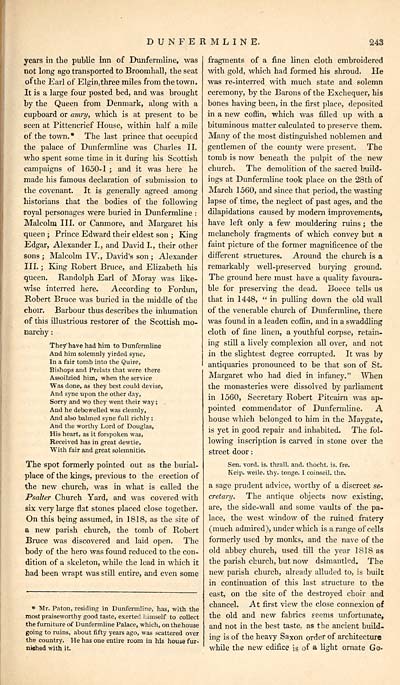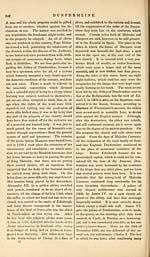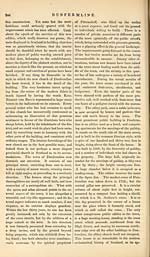Gazetteer of Scotland > Volume 1
(275) Page 243
Download files
Complete book:
Individual page:
Thumbnail gallery: Grid view | List view

DUNFERMLINE.
243
years in the public inn of Dunfermline, was
not long ago transported to Broomhall, the seat
of the Earl of Elgin,three miles from the town.
It is a large four posted bed, and was brought
by the Queen from Denmark, along with a
cupboard or amry, which is at present to be
seen at Pittencrief House, within half a mile
of the town.* The last prince that occupied
the palace of Dunfermline was Charles II.
who spent some time in it during his Scottish
campaigns of 1650-1 ; and it was here he
made his famous declaration of submission to
the covenant. It is generally agreed among
historians that the bodies of the following
royal personages were buried in Dunfermline :
Malcolm III. or Canmore, and Margaret his
queen ; Prince Edward their eldest son ; King
Edgar, Alexander I., and David I., their other
sons; Malcolm IV., David's son; Alexander
III. ; King Robert Bruce, and EUzabeth his
queen. Randolph Earl of Moray was like-
wise interred here. According to Fordun,
Robert Bruce was buried in the middle of the
choir. Barbour thus describes the inhumation
of this illustrious restorer of the Scottish mo-
narchy :
They'havehad him to Dunfermline
And him solemnly yirded syne,
In a fair tomb into the Quire,
Bishops and Prelats that were there
Assoilzied him, when the service
Was done, as they best could devise,
And syne upon the other day,
Sorry and wo they went their way ;
And he debo welled was cleanly,
And also balmed syne full richly ;
And the worthy Lord of Douglas,
His heart, as it forspoken was,
Received has in great dewtie,
With fair and great solemnitie.
The spot formerly pointed out as the burial-
place of the kings, previous to the erection of
the new church, was in what is called the
Psalter Church Yard, and was covered with
six very large flat stones placed close together.
On this being assumed, in 1818, as the site of
a new parish church, the tomb of Robert
Bruce was discovered and laid open. The
body of the hero was found reduced to the con-
dition of a skeleton, while the lead in which it
had been wrapt was still entire, and even some
* Mr. Paton, residing in Dunfermline, has, with the
most praiseworthy good taste, exerted himself to collect
the furniture of Dunfermline Palace, which, on the house
going to ruins, about fifty years ago, was scattered over
the country. He has one entire room in his house fur-
nished with it.
fragments of a fine linen cloth embroidered
with gold, which had formed his shroud. He
was re-interred with much state and solemn
ceremony, by the Barons of the Exchequer, his
bones having been, in the first place, deposited
in a new coffin, which was filled up with a
bituminous matter calculated to preserve them.
Many of the most distinguished noblemen and
gentlemen of the county were present. The
tomb is now beneath the pulpit of the new
church. The demolition of the sacred build-
ings at Dunfermline took place on the 28th of
March 1560, and since that period, the wasting
lapse of time, the neglect of past ages, and the
dilapidations caused by modem improvements,
have left only a few mouldering ruins ; the
melancholy fragments of which convey but a
faint picture of the former magnificence of the
different structures. Around the church is a
remarkably well-preserved burying ground.
The ground here must have a quality favoura-
ble for preserving the dead. Boece tells us
that in 1448, " in pulling down the old wall
of the venerable church of Dunfermline, there
was found in a leaden coffin, and in a swaddling
cloth of fine linen, a youthful corpse, retain-
ing still a lively complexion all over, and not
in the slightest degree corrupted. It was by
antiquaries pronounced to be that son of St.
Margaret who had died in infancy." When
the monasteries were dissolved by parliament
in 1560, Secretary Robert Pitcairn was ap-
pointed commendator of Dunfermline. A
house which belonged to him in the Maygate,
is yet in good repair and inhabited. The fol-
lowing inscription is carved in stone over the
street door :
Sen. vord. is. thrall, and. thocht. is. fre.
Keip. weile. thy. tonge. I coinseil. the.
a sage prudent advice, worthy of a discreet se-
cretary. The antique objects now existing,
are, the side-wall and some vaidts of the pa-
lace, the west window of the ruined fratery
(much admired), under which is a range of cells
formerly used by monks, and the nave of the
old abbey church, used till the year 1818 as
the parish church, but now dsimantled. The
new parish church, already alluded to, is built
in continuation of this last structure to the
east, on the site of the destroyed choir and
chancel. At first view the close connexion of
the old and new fabrics seems unfortunate,
and not in the best taste, as the ancient build-
ing is of the heavy Saxon order of architecture
while the new edifice is of a light ornate Go-
243
years in the public inn of Dunfermline, was
not long ago transported to Broomhall, the seat
of the Earl of Elgin,three miles from the town.
It is a large four posted bed, and was brought
by the Queen from Denmark, along with a
cupboard or amry, which is at present to be
seen at Pittencrief House, within half a mile
of the town.* The last prince that occupied
the palace of Dunfermline was Charles II.
who spent some time in it during his Scottish
campaigns of 1650-1 ; and it was here he
made his famous declaration of submission to
the covenant. It is generally agreed among
historians that the bodies of the following
royal personages were buried in Dunfermline :
Malcolm III. or Canmore, and Margaret his
queen ; Prince Edward their eldest son ; King
Edgar, Alexander I., and David I., their other
sons; Malcolm IV., David's son; Alexander
III. ; King Robert Bruce, and EUzabeth his
queen. Randolph Earl of Moray was like-
wise interred here. According to Fordun,
Robert Bruce was buried in the middle of the
choir. Barbour thus describes the inhumation
of this illustrious restorer of the Scottish mo-
narchy :
They'havehad him to Dunfermline
And him solemnly yirded syne,
In a fair tomb into the Quire,
Bishops and Prelats that were there
Assoilzied him, when the service
Was done, as they best could devise,
And syne upon the other day,
Sorry and wo they went their way ;
And he debo welled was cleanly,
And also balmed syne full richly ;
And the worthy Lord of Douglas,
His heart, as it forspoken was,
Received has in great dewtie,
With fair and great solemnitie.
The spot formerly pointed out as the burial-
place of the kings, previous to the erection of
the new church, was in what is called the
Psalter Church Yard, and was covered with
six very large flat stones placed close together.
On this being assumed, in 1818, as the site of
a new parish church, the tomb of Robert
Bruce was discovered and laid open. The
body of the hero was found reduced to the con-
dition of a skeleton, while the lead in which it
had been wrapt was still entire, and even some
* Mr. Paton, residing in Dunfermline, has, with the
most praiseworthy good taste, exerted himself to collect
the furniture of Dunfermline Palace, which, on the house
going to ruins, about fifty years ago, was scattered over
the country. He has one entire room in his house fur-
nished with it.
fragments of a fine linen cloth embroidered
with gold, which had formed his shroud. He
was re-interred with much state and solemn
ceremony, by the Barons of the Exchequer, his
bones having been, in the first place, deposited
in a new coffin, which was filled up with a
bituminous matter calculated to preserve them.
Many of the most distinguished noblemen and
gentlemen of the county were present. The
tomb is now beneath the pulpit of the new
church. The demolition of the sacred build-
ings at Dunfermline took place on the 28th of
March 1560, and since that period, the wasting
lapse of time, the neglect of past ages, and the
dilapidations caused by modem improvements,
have left only a few mouldering ruins ; the
melancholy fragments of which convey but a
faint picture of the former magnificence of the
different structures. Around the church is a
remarkably well-preserved burying ground.
The ground here must have a quality favoura-
ble for preserving the dead. Boece tells us
that in 1448, " in pulling down the old wall
of the venerable church of Dunfermline, there
was found in a leaden coffin, and in a swaddling
cloth of fine linen, a youthful corpse, retain-
ing still a lively complexion all over, and not
in the slightest degree corrupted. It was by
antiquaries pronounced to be that son of St.
Margaret who had died in infancy." When
the monasteries were dissolved by parliament
in 1560, Secretary Robert Pitcairn was ap-
pointed commendator of Dunfermline. A
house which belonged to him in the Maygate,
is yet in good repair and inhabited. The fol-
lowing inscription is carved in stone over the
street door :
Sen. vord. is. thrall, and. thocht. is. fre.
Keip. weile. thy. tonge. I coinseil. the.
a sage prudent advice, worthy of a discreet se-
cretary. The antique objects now existing,
are, the side-wall and some vaidts of the pa-
lace, the west window of the ruined fratery
(much admired), under which is a range of cells
formerly used by monks, and the nave of the
old abbey church, used till the year 1818 as
the parish church, but now dsimantled. The
new parish church, already alluded to, is built
in continuation of this last structure to the
east, on the site of the destroyed choir and
chancel. At first view the close connexion of
the old and new fabrics seems unfortunate,
and not in the best taste, as the ancient build-
ing is of the heavy Saxon order of architecture
while the new edifice is of a light ornate Go-
Set display mode to: Large image | Transcription
Images and transcriptions on this page, including medium image downloads, may be used under the Creative Commons Attribution 4.0 International Licence unless otherwise stated. ![]()
| Gazetteers of Scotland, 1803-1901 > Gazetteer of Scotland > Volume 1 > (275) Page 243 |
|---|
| Permanent URL | https://digital.nls.uk/97427662 |
|---|
| Description | Volume I: Abbey to Glenartney. |
|---|---|
| Attribution and copyright: |
|
| Description | By Robert Chambers and William Chambers. Glasgow: Blackie & Son, 1838. 2 volumes. |
|---|---|
| Shelfmark | NF.1461.g.7 |
| Additional NLS resources: | |

